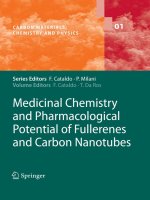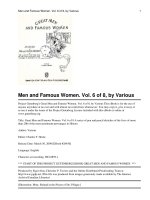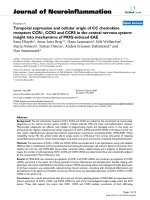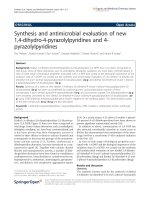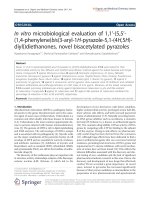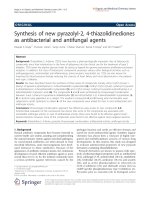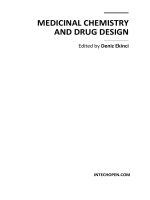Burgers medicinal chemistry and drug discovery vol 6 nervous system agents
Bạn đang xem bản rút gọn của tài liệu. Xem và tải ngay bản đầy đủ của tài liệu tại đây (31.79 MB, 1,080 trang )
BURGER'S MEDICINAL
CHEMISTRY AND
DRUG DISCOVERY
Sixth Edition
Volume 6: Nervous System Agents
Edited by
Donald j. Abraham
Department of Medicinal Chemistry
School of Pharmacy
Virginia Commonwealth University
Richmond, Virginia
WILEYINTERSCIENCE
A john Wiley and Sons, Inc., Publication
CONTENTS
5 SEDATIVE-HYPNOTICS, 201
1 ADRENERGICS AND
ADRENERGIC-BLOCKING
AGENTS, 1
Julius Vida
Vida International Pharmaceutical
Consultants
Greenwich, Connecticut
Robert K. Griffith
West Virginia University
School of Pharmacy
Morgantown, West Virginia
Joseph Yevich
Pharmaceutical Research Institute
Bristol-Myers Squibb Company
Wallingford, Connecticut
2 CHOLINERGICS, 39
Joseph G. Cannon
The University of Iowa
Iowa City, Iowa
6 ANTICONVULSANTS, 263
Kenneth R. Scott
School of Pharmacy
Howard University
Washington, DC
3 ANTICHOLINERGIC DRUGS, 109
B. V . Rama Sastry
School of Medicine
Vanderbilt University
Nashville, Tennessee
7 NARCOTIC ANALGESICS, 329
Jane V . Aldrich
Sandra C. Vigil-Cruz
Department of Medicinal Chemistry
School of Pharmacy
University of Kansas
Lawrence, Kansas
4 CNS STIMULANTS, 167
David E. Nichols
Department of Medicinal Chemistry
and
Molecular Pharmacology
School of Pharmacy and Pharmacal
Sciences
Purdue University
Indiana, West Lafayette
xiii
Contents
xiv
8 ANTIDEPRESSANTS, 483
Leslie Iversen
University of Oxford
Department of Pharmacology
Oxford, United Kingdom
Richard A. Glennon
Virginia Commonwealth University
School of Pharmacy
Richmond, Virginia
9 ANTIANXIETY AGENTS, 525
Kevin S. Currie
Neurogen Corporation
Branford, Connecticut
12 THERAPEUTIC AND
DIAGNOSTIC AGENTS FOR
PARKINSON'S DISEASE, 711
John L. Neumeyer
Ross J. Baldessarini
Harvard Medical School
McLean Hospital
Belmont, Massachusetts
Raymond G. Booth
School of Pharmacy
The University of North Carolina
Chapel Hill, North Carolina
13 ALZHEIMER'S DISEASE:
SEARCH FOR THERAPEUTICS,
743
10 ANTIPSYCHOTIC AGENTS, 599
C. Anthony Altar
Psychiatric Genomics, Inc.
Department of Gene Discovery
Gaithersburg, Maryland
Arnold R. Martin
University of Arizona
Department of Pharmacology
College of Pharmacy
Tucson, Arizona
Andrew Thurkauf
Neurogen Corporation
Department of Medicinal Chemistry
Branford, Connecticut
W. Janusz Rzeszotarski
Food and Drug Administration
Rockville, Maryland
14 COGNITION ENHANCERS, 779
Clark N. Eid, Jr.
Yong-Jin Wu
Division of Central Nervous System
Chemistry
Bristol-Myers Squibb
Pharmaceutical Research Institute
Wallingford, Connecticut
Gene G. Kinney
Department of Neuroscience
Merck Research Laboratories
West Point, Pennsylvania
11 INVESTIGATIVE AGENTS FOR
USE IN NEURODEGENERATIVE
CONDITIONS, 673
James David Adams Jr.
Department of Molecular
Pharmacology and Toxicology
USC School of Pharmacy
Los Angeles, California
Thomas F. Woolf
HyBar BioScience, LLC
Ann Arbor, Michigan
15 DRUGS TO TREAT EATING
AND BODY WEIGHT
DISORDERS, 837
Philip A. Carpino
John R. Hadcock
Pfizer Global Research &
Development-Groton Labs
Department of Cardiovascular and
Metabolic Diseases
Groton, Connecticut
INDEX, 895
CUMULATIVE INDEX, 923
BURGER'S
MEDICINAL CHEMISTRY
AND
DRUG DISCOVERY
CHAPTER ONE
Adrenergics and AdrenergicBlocking Agents
ROBERT K. GRIFFITH
School of Pharmacy
West Virginia University
Morgantown, West Virginia
Contents
1 Introduction, 2
2 Clinical Applications, 2
2.1 Current Drugs, 2
2.1.1 Applications of General Adrenergic
Agonists, 9
2.1.2 Applications of a,-Agonists, 12
2.1.3 Applications of a,-Agonists, 13
2.1.4 Applications of p-Agonists, 14
2.1.5 Applications of Antiadrenergics, 14
2.1.6 Applications of Nonselective aAntagonists, 15
2.1.7 Applications of Selective a,Antagonists, 15
2.1.8 Applications of p-Antagonists,16
2.1.9 Applications of alp-Antagonists, 16
2.1.10 Applications of Agonists/Antagonists,
16
2.2 Absorption, Distribution, Metabolism, and
Elimination, 16
2.2.1 Metabolism of Representative
Phenylethylamines, 16
2.2.2 Metabolism of Representative
Imidazolines and Guanidines, 18
2.2.3 Metabolism of Representative
Quinazolines, 19
2.2.4 Metabolism of Representative Aryloxypropanolamines, 19
3 Physiology and Pharmacology, 21
3.1 Physiological Significance, 21
3.2 Biosynthesis, Storage, and Release
of Norepinephrine, 22
3.3 Effector Mechanisms
of Adrenergic Receptors, 25
3.4 Characterization of Adrenergic
Receptor Subtypes, 25
4 History, 26
Burger's Medicinal Chemistry and Drug Discovery
Sixth Edition, Volume 6: Nervous System Agents
Edited by Donald J. Abraham
ISBN 0-471-27401-1 02003 John Wiley & Sons, Inc.
1
Adrenergics and Adrenergic-Blocking Agents
5 Structure-Activity Relationships, 28
5.1 Phenylethylamine Agonists, 28
5.1.1 R1 Substitution on the Amino Nitrogen,
28
5.1.2 R2 Substitution a to the Basic
Nitrogen, Carbon-2,28
5.1.3 R3 Substitution on Carbon-1, 29
5.1.4 R4 Substitution on the Aromatic Ring,
29
1
INTRODUCTION
In both their chemical structures and biological activities, adrenergics and adrenergicblocking agents constitute an extremely varied group of drugs whose clinical utility
includes prescription drugs to treat lifethreatening conditions such as asthma and
hypertension as well as nonprescription medications for minor ailments such as the common cold. This extensive group of drugs includes synthetic agents as well as chemicals
derived from natural products that have been
used in traditional medicines for centuries.
Many adrenergic drugs are among the most
commonly prescribed medications in the
United States, including bronchodilators,
such as albuterol (13) for use in treating
asthma, and antihypertensives, such as atenolo1 (46) and doxazosin (42). Nonprescription
adrenergic drugs include such widely used nasal decongestants as pseudoephedrine (5)and
naphazoline (29). Most of these varied drugs
exert their therapeutic effects through action
on adrenoceptors, G-protein-coupled cell surface receptors for the neurotransmitter norepinephrine (noradrenaline, I), and the adrenal hormone epinephrine (adrenaline, 2).
(1) norepinephrine, R = H
(2) epinephrine, R = CH3
Adrenoceptors are broadly classified into aand preceptors, with each group being further
5.1.5 Imidazolines and Guanidines, 30
5.1.6 Quinazolines, 31
5.1.7 Aryloxypropanolamines, 32
6 Recent Developments, 33
6.1 Selective a,-Adrenoceptor Antagonists, 33
6.2 Selective P,-Agonists, 34
subdivided. Identification of subclasses of adre
noceptors has been greatly aided by the tools of
molecular biology and, to date, six distinct a-adrenoceptors (a,,, a,,, a,,, ~ Z A ~, Z B ,aZd,and
three distinct P-adrenoceptors (PI, P,, P,) have
been clearly identified (I), with conflicting evidence for a fourth type of /3 (P,) (13). In general
the most common clinical applications of a,-agonists are as vasoconstrictors employed as nasal
decongestants and for raising blood pressure in
shock; a,-agonists are employed as antihypertensives; a,-antagonists (a-blockers) are vasodilators and smooth muscle relaxants employed as
antihypertensives and for treating prostatic hyperplasia; p-antagonists (p-blockers) are employed as antihypertensives and for treatingcardiac arrhythmias; and p-agonists are employed
as bronchodilators. The most novel recent advances in adrenergic drug research have been
directed toward development of selective p,-agonists that have potential applications in treatment of diabetes and obesity (4-8).
2
2.1
CLINICAL APPLICATIONS
Current Drugs
U.S. Food and Drug Administration (FDA)approved adrenergic and antiadrenergic drugs
currently available in the United States are
summarized in Table 1.1, which is organized
in general according to pharmacological mechanisms of action and alphabetically within
those mechanistic classes. Structures of the
currently employed drugs are given in Tables
1.2-1.6 according to chemical class. Drugs in a
given mechanistic class often have more than
one therapeutic application, and may or may
not all be structurally similar. Furthermore,
drugs from several different mechanistic
classes may be employed in a given therapeu-
Table 1.1 Adrenergic and Antiadrenergic Pharmaceuticals
Class and Generic Name
General agonists
Amphetamine ( 3 )
Dipivefrin ( 4 )
Ephedrine erythro-(5)
Epinephrine ( 2 )
w
Mephentermine ( 6 )
Norepinephrine (1)
Pseudoephedrine threo(5)
a,-Agonists
Levonordefrin ( 7 )
Metaraminol(8)
Methoxamine ( 9 )
Midodrine (10)
Trade Namea
Originator
Chemical Class
Dosebc
Adderall, Dexedrine
Propine
various
SmithKline & French
Klinge
Phenylethylamine
Phenylethylamine
Phenylethylamine
Adrenaline
Parke-Davis
Phenylethylamine
Wyamine
Levophed
various
Wyeth
Sterling
Phenylethylamine
Phenylethylamine
Phenylethylamine
5-60 mglday
1 drop 2 X daily 0.1% soln.
50-150 mglday for asthma
10-25 mg i.v. for hypotension
0.3-1.5 mg S.C.
2-10 pglmin i.v.
160-250 pg inh.
30-45 mg, i.m.
0.5-30 pglmin i.v.
60-240 mglday
na
Aramine
Vasoxyl
Prohatine
Phenylethylamine
Phenylethylamine
Phenylethylamine
Phenylethylamine
1:20,000 in local anesthetics
2-10 mg, i.m.
10-20 mg, i.m.
30 mglday
Imidazoline
1-2 drops 0.05% nasal
0.03% ophthalmic
1-2 drops 0.05% nasal
0.025% ophthalmic
1-3 drops
0.25-0.5% soln. nasal
0.1-0.5 mg i.v. for shock
1-2 drops of 0.05%.soln.
2-3 drops of 0.1% soln.
Naphazoline (29)
various
Winthrop
Sharpe & Dohme
Burroughs Wellcome
Oesterreichische
Stickstoffwerke
Ciba
Oxymetazoline (30)
various
Merck
Imidazoline
Phenylephrine (11)
various
F. Stearns & Co.
Phenylethylamine
Tetrahydrozoline (31)
Xylometazoline (32)
a,-Agonists
Apraclonidine (33)
Brimonidine (34)
Clonidine (35)
Guanabenz (36)
Guanfacine (37)
Methyldopa (12)
Various
Sahyun
Ciba
Imidazoline
Imidazoline
Iopidine
Alphagan
Catapress
Wytensin
Tenex
Aldomet
Alcon
Pfizer
Boehringer
Sandoz
Wander
Merck
Aminoimidazoline
Aminoimidazoline
Aminoimidazoline
Arylguanidine
Arylguanidine
Aromatic amino acid
3-6 drops 0.51% soln.
1 drop 0.2% soln., 3 x daily
0.2-1.2 mglday
8-32 mglday
1-3 mglday
500-2000 mglday
Table 1.1 (Continued)
Class and Generic Name
Bitolterol(14)
Formoterol(15)
Isoetharine (16)
Isoproterenol(l7)
Salmeterol(21)
Terbutaline (22)
Antiadrenergics
Guanadrel(38)
Guanethidine (39)
Reserpine (60)
Metyrosine (23)
a-Antagonists
Dapiprazole (61)
Phenoxybenzamine (62)
Phentolamine (40)
Tolazoline (41)
Selective
a,-antagonists
Doxazosin (42)
Prazosin (43)
Tamsulosin (24)
Terazosin (44)
Trade Namea
Originator
Dosebc
Chemical Class
Proventil, Ventolin
Allen & Hanburys
Phenylethylamine
Tornalate
Foradil
Bronkosol
Isuprel
Sterling
Yamanouchi
I. G. Farben
Boehringer
Phenylethylamine
Phenylethylamine
Phenylethylamine
Phenylethylamine
Xopenex
Alupent, Metaprel
Sepracor
Boehringer
Phenylethylamine
Phenylethylamine
Maxair
Yutopar
Pfizer
Philips
Pyridylethylamine
Phenylethylamine
Serevent
Brethine
Glaxo
Draco
Phenylethylamine
Phenylethylamine
12-32 mg/day p.0.
2.5 mg 3 4 X daily, neb.
0.74-2.22 inh.
12 pg, 2 x daily inh.
2 mL 0.25% soln. inh.
120-262 pg, 24% daily inh.
0 5 5 . 0 pg/min, i.v.
0.63-1.25 mg 3X daily neb.
60-80 mg/day p.0.
1.3-1.95 mg, M x daily, inh.
0.2-0.4 mg 4-6X daily, inh.
150-350 pg/min, i.v.
120 mglday
42 pg, 2X daily, inh.
7.5-15 mg/day
Hylorel
Ismelin
reserpine
Demser
Cutter
Ciba
Ciba
Merck
Guanidine
Guanidine
Alkaloid
Aromatic amino acid
10-75 mglday
10-50 mg/day
0.05-0.5 mg/day
14 g/day
Rev-Eyes
Dibenzylime
Regitine
Priscoline
Angelini-Francesco
SmithKline & French
Ciba
Ciba
Piperidinlytriazole
Haloalkylamine
Imidazoline
Imidazoline
2 drops 0.5% soln.
20-120 mglday
5-10 mg i.v.
40-200 mg/day
Cardura
Minipress
Pfizer
Pfizer
Quinazoline
Quinazoline
Flomax
Hytrin
Yamanouchi
Abbott
Phenylethylamine
Quinazoline
1-16 mg/day
1-9 mglday for BPH
6-20 mglday for hypertension
0.4-0.8 mg/day
5-20 mg/day
Bisoprolol(48)
Carteolol(49)
Esmolol(50)
Levobetaxolol S-(-1447)
Levobunolol (51)
Metipranolol (52)
Metoprolol(53)
alp-Antagonists
Carvedilol(59)
Labetalol(26)
AgonistlAntagonists
Dobutamine (27)
Isoxsuprine
(28)
-
200-1200 mglday
25-150 mglday
Hypertension: 10-20 mg orally
Glaucoma: 1-2 drops 0.5% soh. 2 x daily
1.25-20 mglday
2.5-10 mglday
50-100 pg/kg/min
1 drop 0.5% soln., 2X daily
1-2 drops 0.5% soln., 1-2X daily
1 drop 0.3% soln.., 2 x daily
100-450 mglday
XL 50-100 mglday
40-320 mglday
20-80 mglday
10-60 mglday
160-640 mglday
160-320 mglday
Hypertension: 10-60 mglday
Glaucoma: 1 drop 0.25% soln., 2X daily
Sectral
Tenormin
Betoptic, Kerlone
May & Baker
ICI
Synthelabo
Aryloxypropanolamine
Aryloxypropanolamine
Aryloxypropanolamine
Zebeta
Cartrol, Ocupress
Brevibloc
Betaxon
Betagan
OptiPranolol
Lopressor, Toprol-XL
Toprol-XL
Corgard
Levatol
Visken
Inderal, Inderal LA
Betapace
Timoptic
Merck
Otsuka
American Hospital Supply
Alcon
Warner-Lambert
Boehringer
AB Hksle
Aryloxypropanolamine
Aryloxypropanolamine
Aryloxypropanolamine
Aryloxypropanolamine
Aryloxypropanolamine
Aryloxypropanolamine
Aryloxypropanolamine
Squibb
Hoechst
Sandoz
ICI
Mead Johnson
Frosst
Aryloxypropanolamine
Aryloxypropanolamine
Aryloxypropanolamine
Aryloxypropanolamine
Phenylethylamine
Aryloxypropanolamine
Coreg
Normodyne
Boehringer
Allen & Hanburys
Aryloxypropanolamine
Phenylethylamine
13-50 mglday
200-2400 mglday
Dobutrex
Vasodilan
Lilly
Philips
Phenylethylamine
Arylpropanolamine
2-20 pgkglmin, i.v.
30-80 mglday
"Not all trade names are listed, particularly for drugs no longer under patent.
bAU dose information from Drug Facts a n d Comparisons 2002(14).
"Not all doses and dosage forms are listed. For further information consult reference (14).
Table 1.2
Phenylethylamines (Structures 1-28)
R4
4'
\
5'
Compound
(1)
(2)
(3)
(4)
(5)
m
(6)
(7)
(8)
(9)
(10)
(11)
(12)
(13)
(14)
(15)
R1
H
CH3
H
CH3
CH3
cH3
H
H
H
COCH,NH2
CH3
H
C(CH3)3
C(CH3I3
Y Q
R2
R3
H
H
CH3
H
CH3
2,2-diCH3
CH3
CH3
CH3
H
H
2-CH,, 2-C02H
H
H
H
OH
OH
H
OH
OH
OH
OH
OH
OH
OH
OH
H
OH
OH
OH
3',4'-diOH
3',4'-diOH
H
3',4'-di-02CC(CH3),
H
H
3',4'-&OH
3'-OH
2',5'-diOCH3
2',5'-diOCH3
3'-OH
3',4'-&OH
3'-CH20H, 4'-OH
CH2CH3
H
H
H
cH3
OH
OH
OH
OH
OH
R4
Receptor Activity"
a+@
pza!
+ mb
(P 2 a!)"
(a! + P ) ~
(a + PIb
(a!
a
a!
a!
a!
a
azC
3',4'-bis(02CC,H4-p-CH,)
Pz
Pzc
3'-NHCHO, 4'-OH
P2
3',4'-diOH
3',4'-&OH
3',5'-diOH
2'-aza, 3'-CH20H, 4'-OH
4'-OH
P
P
P2
PZ
0CH3
(16)
(17)
(18)
(19)
(20)
CH(CH3I2
CH(CH&
C(CH&
C(CH3I3
OH
P2
CH~
"Agonist activity unless indicated otherwise.
bIndirectactivity through release of norepinephrine and reuptake inhibition.
"Prodrug.
dMixeddirect and indirect activity.
'Norepinephrine biosynthesis inhibitor.
fNet sum of effects of enantiomers.
Adrenergics and Adrenergic-Blocking Agents
8
Table 1.3 Imidazolines and Guanidines (Structures 29- 41)
Compound
Structure
Receptor Activity
2 Clinical Applications
Table 1.3 (Continued)
Compound
Structure
Receptor Activity
"Inhibit release of norepinephrine.
tic application; for example, p-blockers, a,blockers, and a,-agonists are all employed to
treat hypertension.
2.1.1 Applications of General Adrenergic
Agonists. The mixed a- and p-agonist norepi-
nephrine (1)has limited clinical application
because of the nonselective nature of its action
in stimulating the entire adrenergic system.
In addition to nonselective activity, it is orally
inactive because of rapid first-pass metabolism of the catechol hydroxyls by catechol-0methyl-transferase (COMT) and must be administered intravenously. Rapid metabolism
limits its duration of action to only 1 or 2 min,
even when given by infusion. Because its a-activity constricts blood vessels and thereby
raises blood pressure, (1)is used to counteract
various hypotensive crises and as an adjunct
treatment in cardiac arrest where its p-activity stimulates the heart. Although it also lacks
oral activity because it is a catechol, epinephrine (2) is far more widely used clinically than
(1).Epinephrine, like norepinephrine, is used
to treat hypotensive crises and, because of its
greater p-activity, is used to stimulate the
heart in cardiac arrest. When administered intravenously or by inhalation, epinephrine's
&activity makes it useful in relieving bronchoconstriction in asthma. Because it has significant a-activity, epinephrine is also used in
topical nasal decongestants. Constriction of
dilated blood vessels by a-agonists in mucous
membranes shrinks the membranes and re-
Adrenergics and Adrenergic-Blocking Agents
10
Table 1.4 Quinazolines (Structures 42-44)
R
Receptor Activity
duces nasal congestion. Dipivefrin (4) is a prodrug form of (2), in which the catechol hydroxyls are esterified with pivalic acid.
Dipivefrin is used to treat open-angle glaucoma through topical application to the eye
where the drug (4) is hydrolyzed to epinephrine (2),which stimulates both a-and P-receptors, resulting in both decreased production
and increased outflow of aqueous humor,
which in turn lowers intraocular pressure.
Amphetamine (3) is orally active and,
through an indirect mechanism, causes a general activation of the adrenergic nervous system. Unlike (1)and (2), amphetamine readily
crosses the blood-brain barrier to activate a
number of adrenergic pathways in the central
nervous system (CNS). Amphetamine's CNS
activity is the basis of its clinical utility in
treating attention-deficit disorder, narcolepsy, and use as an anorexiant. These therapeutic areas are treated elsewhere in this
volume.
Ephedrine erythro-(5) and pseudoephedrine threo-(5) are diastereomers with ephedrine, a racemic mixture of the R,S and S,R
stereoisomers, and pseudoephedrine, a race-
mic mixture of R,R and S,S stereoisomers.
Ephedrine is a natural product isolated from
several species of ephedra plants, which were
used for centuries in folk medicines in a variety of cultures worldwide (9). Ephedrine has
both direct activity on adrenoceptors and indirect activity, through causing release of norepinephrine from adrenergic nerve terminals.
Ephedrine is widely used as a nonprescription
bronchodilator. It has also been used as a vasopressor and cardiac stimulant. Lacking phenolic hydroxyls, ephedrine crosses the bloodbrain barrier far better than does epinephrine.
Because of its ability to penetrate the CNS,
ephedrine has been used as a stimulant and
exhibits side effects related to its action in the
brain such as insomnia, irritability, and anxiety. It suppresses appetite and in high doses
can cause euphoria or even hallucinations. In
the United States the purified chemical ephedrine is considered a drug and regulated by the
FDA. However, the dried plant material ma
huang is considered by law to be a dietary supplement, and not subject to FDA regulation.
As a result there are a large number of ma
huang-containing herbal remedies and "nu-
Compound
2 Clinical Applications
11
Table 1.5 Aryloxypropanolamines (Structures 45-59)
OH
Rn-o&NHCompound
ARYL
R
Receptor Selectivity"
Adrenergics and Adrenergic-Blocking Agents
12
Table 1.5 (Continued)
Compound
ARYL
R
Receptor Selectivitya
Plt Pz
triceuticals" on the market whose active ingredient is the adrenergic agonist ephedrine.
Pseudoephedrine, the threo diastereomer, has
virtually no direct activity on adrenergic receptors but acts by causing the release of norepinephrine from nerve terminals, which in
turn constricts blood vessels. Although it too
crosses the blood-brain barrier, pseudoephedrine's lack of direct activity affords fewer CNS
side effects than does ephedrine. Pseudoephedrine is widely used as a nasal decongestant and is an ingredient in many nonprescription cold remedies.
Mephentermine (8) is another general adrenergic agonist with both direct and indirect
activity. Mephentermine's therapeutic utility
is as a parenteral vasopressor used to treat
hypotension induced by spinal anesthesia or
other drugs.
2.1.2 Applications of a,-Agonists. All se-
lective a,-agonists are vasoconstrictors, which
is the basis of their therapeutic activity. The
sole use of levonordefrin (7)is in formulations
with parenteral local anesthetics employed in
dentistry. Vasoconstriction induced by the
a-agonist activity of (7) helps retain the local
anesthetic near the site of injection and prolongs the duration of anesthetic activity. Metaraminol (8) and methoxamine (9) are both
parenteral vasopressors selective for a-receptors and so have few cardiac stimulatory properties. Because they are not substrates for
COMT, their duration of action is significantly
longer than that of norepinephrine, but their
primary use is limited to treating hypotension
during surgery or shock. Methoxamine is also
used in treating supraventricular tachycardia.
Midodrine (10) is an orally active glycine-
To%
2 Clinical Applications
Table 1.6 Miscellaneous AdrenergiclAntiadrenergics(Structures 60-62)
Compound
(60)
Structure
Pharmacological Activity
Antiadrenergic
H\\\'
CH302C
0CH3
=-
OCH~
0CH3
0CH3
(61)
N-N
H3C
amide prodrug, hydrolyzed in vivo to (63), an
analog of methoxamine, and a vasoconstrictor.
Midodrine is used to treat orthostatic hypotension.
severe hypotension or shock but is much
more widely employed as a nonprescription
nasal decongestant in both oral and topical
preparations.
The imidazolines naphazoline (29), oxymetazoline (301,tetrahydozoline (31),and xylometazoline (32) are all selective a,-agonists,
widely employed as vasoconstrictors in topical
nonprescription drugs for treating nasal congestion or bloodshot eyes. Naphazoline and
oxymetazoline are employed in both nasal decongestants and ophthalmic preparations,
whereas tetrahydrozoline is currently marketed only for ophthalmic use and xylometazoline only as a nasal decongestant.
2.1.3 Applications of a,-Agonists. Arnino-
Phenylephrine (111, also a selective a-agonist, may be administered parenterally for
imidazolines apraclonidine (33) and brimonidine (34) are selective a,-agonists employed topically in the treatment of glaucoma.
Stimulation of a,-receptors in the eye reduces
production of aqueous humor and enhances
outflow of aqueous humor, thus reducing intraocular pressure. Brimonidine is substantially more selective for a,-receptors over a,-
Adrenergics and Adrenergic-Blocking Agents
receptors than is apraclonidine. Although both
are applied topically to the eye, measurable
quantities of these drugs are detectable in
plasma, so caution must be employed when
the patient is also taking cardiovascular
agents. Structurally related aminoimidazoline
clonidine (35) is a selective a2-agonist taken
orally for treatment of hypertension. The antihypertensive actions of clonidine are mediated
through stimulation of a,-adrenoceptors
within the CNS, resulting in an overall decrease
in peripheral sympathetic tone. Guanabenz (36)
and guanfacine (37) are ring-opened analogs of
(351, acting by the same mechanism and employed as centrally acting antihypertensives.
Methyldopa (12) is another antihypertensive agent acting as an a,-agonist in the CNS
through its metabolite, a-methyl-norepinephrine (65). Methyldopa [the drug is the L-(5')stereoisomer] is decarboxylated to a-methyldopamine (64) followed by stereospecific
p-hydroxylation to the (1R,2S) stereoisomer
of a-methylnorepinephrine (65). This stereoisomer is an a,-agonist that, like clonidine,
guanabenz, and guanfacine, causes a decrease
in sympathetic output from the CNS.
formoterol (15), isoetharine (16),isoprotereno1 (17), levalbuterol [R-(-)-(1311, metaproterenol (18), pirbuterol (191, salmeterol (21),
and terbutaline (22) are used primarily as
bronchodilators in asthma and other constrictive pulmonary conditions. Isoproterenol(17)
is a general P-agonist; and the cardiac stimulation caused by its &-activity and its lack of
oral activity attributed to first-pass metabolism of the catechol ring have led to diminished use in favor of selective p,-agonists.
Noncatechol-selective P2-agonists,such as albuterol (13), metaproterenol (181, and terbutaline (22), are available in oral dosage
forms as well as in inhalers. All have similar
activities and durations of action. Pirbuterol
(19) is an analog of albuterol, in which the
benzene ring has been replaced by a pyridine
ring. Similar to albuterol, (19) is a selective
P2-agonist,currently available only for administration by inhalation. Bitolterol(14) is a prodrug, in which the catechol hydroxyl groups
have been converted to 4-methylbenzoic acid
esters, providing increased lipid solubility and
prolonged duration of action. Bitolterol is administered by inhalation, and the ester groups
are hydrolyzed by esterases to liberate the active catechol drug (66), which is subject to metabolism by COMT, although the duration of
action of a single dose of the prodrug is up to
8 h, permitting less frequent administration
and greater convenience to the patient. More
recently developed selective &-agonist bronchodilators are formoterol(l5) and salmeterol
(21),which have durations of action of 12 h or
more. Terbutaline (221, in addition to its use
as a bronchodilator, has also been used for
halting the contractions of premature labor.
Ritodrine (20) is a selective P2-agonist that is
used exclusively for relaxing uterine muscle
and inhibiting the contractions of premature
labor.
2.1.5 Applications of Antiadrenergics. Gua-
2.1.4 Applications of fi-Agonists. Most of
the /3-selective adrenergic agonists, albuterol
(13; salbutamol in Europe), bitolterol (141,
nadrel (38) and guanethidine (39) are orally
active antihypertensives, which are taken up
into adrenergic neurons, where they bind to
the storage vesicles and prevent release of
neurotransmitter in response to a neuronal
impulse, which results in generalized decrease
in sympathetic tone. These drugs are available
but seldom used.
2 Clinical Applications
in pheochromocytoma tumors, it is not useful
for treating essential hypertension.
2.1.6 Applications of Nonselective a-Antagonists. Because antagonism of a,-adreno-
Reserpine (60)is an old and historically important drug that affects the storage and release of norepinephrine. Reserpine is one of
several indole alkaloids isolated from the roots
of Rauwolfia serpentina, a plant whose roots
were used in India for centuries as a remedy
for snakebites and as a sedative. Reserpine
acts to deplete the adrenergic neurons of their
stores of norepinephrine by inhibiting the active transport Mg-ATPase responsible for sequestering norepinephrine and dopamine
within the storage vesicles. Monoamine oxidase (MAO) destroys the norepinephrine and
dopamine that are not sequestered in vesicles.
As a result the storage vesicles contain little
neurotransmitter; adrenergic transmission is
dramatically inhibited; and sympathetic tone
is decreased, thus leading to vasodilation.
Agents with fewer side effects have largely replaced reserpine in clinical use.
Metyrosine (23, a-methyl-L-tyrosine), a
norepinephrine biosynthesis inhibitor, is in
limited clinical use to help control hypertensive episodes and other symptoms of catecholamine overproduction in patients with the
rare adrenal tumor pheochromocytoma (10).
Metyrosine, a competitive inhibitor of tyrosine hydroxylase, inhibits the production of
catecholamines by the tumor. Although metyrosine is useful in treating hypertension
caused by excess catecholamine biosynthesis
ceptors in the peripheral vascular smooth
muscle leads to vasodilation and a decrease in
blood pressure attributed to a lowering of peripheral resistance, alpha-blockers have been
employed as antihypertensives for decades.
However, nonselective a-blockers such as phenoxybenzamine (62), phentolamine (40), and
tolazoline can also increase sympathetic output through blockade of inhibitory presynaptic a,-adrenoceptors, resulting in an increase
in circulating norepinephrine, which causes
reflex tachycardia. Thus the use of these
agents in treating most forms of hypertension
has been discontinued and replaced by use of
selective a,-antagonists discussed below. Current clinical use of the nonselective agents
(40), (41), and (62) is primarily treatment of
hypertension induced by pheochromocytoma,
a tumor of the adrenal medulla, which secretes large amounts of epinephrine and norepinephrine into the circulation. Dapiprazole
(61) is an ophthalmic nonselective a-antagonist applied topically to reverse mydriasis induced by other drugs and is not used to treat
hypertension.
2.1.7 Applications of Selective a,-Antagonists. Quinazoline-selective a,-blockers doxazosin (42), prazosin (43), and terazosin (44)
have replaced the nonselective a-antagonists
in clinical use as antihypertensives. Their ability to dilate peripheral vasculature has also
made these drugs useful in treating Raynaud's
syndrome. The a,-selective agents have a favorable effect on lipid profiles and decrease
low density lipoproteins (LDL) and triglycerides, and increase high density lipoproteins
(HDL).
Contraction of the smooth muscle of the
prostate gland, prostatic urethra, and bladder
neck is also mediated by a,-adrenoceptors,
with a,, being predominant, and blockade of
these receptors relaxes the tissue. For this reason the quinazoline a,-antagonists doxazosin
(42), prazosin ( 4 9 , and terazosin (44) have
also found use in treatment of benign prostatic hyperplasia (BPH). However, prazosin,
Adrenergics and Adrenergic-Blocking Agents
doxazosin, and terazosin show no significant
selectivity for any of the three known a,-adrenoceptor subtypes, a,,, a,,, and a,, (11).The
structurally unrelated phenylethylamine a,antagonist tamsulosin (24) is many fold more
selective for a,,-receptors than for the other
a,-adrencoceptors. Tamsulosin is employed
only for treatment of BPH, given that it has
little effect on the a,,- and a,,-adrenoceptors,
which predominate in the vascular bed (12)
and have little effect on blood pressure (13).
2.1.8 Applications of &Antagonists. p-Antagonists are among the most widely employed
antihypertensives and are also considered the
first-line treatment for glaucoma. There are
16 p-blockers listed in Table 1.1 and 15 of
them are in the chemical class of aryloxypropanolamines. Only sotalol(25) is a phenylethylamine. Acebutolol (451, atenolol (46), bisopro101 (481, metoprolol (53), nadolol (54),
penbutolol (551, pindolol (561, and propranolo1 (57)are used to treat hypertension but not
glaucoma. Betaxolol (471, carte0101 (49), and
timolol(58)are used both systemically to treat
hypertension and topically to treat glaucoma.
Levobetaxolol [S-(-)-(47)], levobunolol (51),
and metipranolol (52) are employed only in
treating glaucoma. Betaxolol (racemic 47) is
available in both oral and ophthalmic dosage
forms for treating hypertension and glaucoma, respectively, but levobetaxolol, the enantiomerically pure S-(-)-stereoisomer is currently available only in an ophthalmic dosage
form. Esmolol (50) is a very short acting
p-blocker administered intravenously for
acute control of hypertension or certain supraventricular arrhythmias during surgery.
Sotalol(25)is a nonselective p-blocker used to
treat ventricular and supraventricular arrhythmias not employed as an antihypertensive or antiglaucoma agent. P-Antagonists
must be used with caution in patients with
asthma and other reactive pulmonary diseases
because blockade of P,-adrenoceptors may exacerbate the lung condition. Even the agents
listed as being &-selective have some level of
p,-blocking activity at higher therapeutic
doses. Betaxolol is the most p,-selective of the
currently available agents.
2.1.9 Applications of dj3-Antagonists. Carvedilol (591, an aryloxypropanolamine, has
both a- and p-antagonist properties and is
used both as an antihypertensive and to treat
cardiac failure. Both enantiomers have selective a,-antagonist properties but most of the
p-antagonism is attributable to the S-(-)isomer. Labetalol(26) is also an antihypertensive
with both selective a,-antagonist properties
and nonselective p-antagonism. Labetalol is
an older drug than carvedilol and is not as
potent as carvedilol, particularly as a p-antagonist.
2.1 .I 0 Applications of Agonists/Antagonists. Dobutamine (27) is a positive inotropic
agent administered intravenously for congestive heart failure. The (+)-isomer has both a
and p agonist effects, whereas the (-)-isomer
is an a-antagonist but a P-agonist like the enantiomer. The p-stirnulatory effects predominate as the a-effects cancel. As a catechol it
has no oral activity and even given intravenously has a half-life of only 2 min. Isoxsuprine (28) is an agent with a-antagonist and
P-agonist properties, which has been used for
peripheral and cerebral vascular insufficiency
and for inhibition of premature labor. Isoxsuprine is seldom used any more.
Absorption, Distribution, Metabolism,
and Elimination
2.2
Because of the large numbers of chemicals acting as either adrenergics or adrenergic-blocking drugs, only representative examples will
be given and limited to metabolites identified
in humans. Because drugs with similar structures are often metabolized by similar routes,
the examples chosen are representative of
each structural class. Although it contains no
structural details of metabolic pathways,
Drug Facts and Comparisons (14) is an outstanding comprehensive compilation of pharmacokinetic parameters such as absorption,
duration of action, and routes of elimination
for drugs approved by the FDA for use in the
United States.
2.2.1 Metabolism of Representative Phenylethylamines. Norepinephrine (1) and epinephrine (2) are both substrates for MAO,
2 Clinical Applications
shown. Any catechol-containing drug will also
likely be subject to metabolism by COMT.
Ephedrine (51, a close structural analog of
(2), having no substituents on the phenyl ring,
is well absorbed after an oral dose and over
half the dose is eliminated unchanged in the
urine. The remainder of the dose is largely
desmethylephedrine (72), deamination product (73), and small amounts of benzoic acid
and its conjugates (16). No aromatic ring-hydroxylation products were detected. This is in
marked contrast to the case with amphetamine (3), in which ring-hydroxylated products are major metabolites.
Albuterol(13) is not subject to metabolism
by COMT and is orally active but does have a
4'- OH group subject to conjugation. The major metabolite of albuterol (13) is the 4'-0sulfate (74) (17). The sulfation reaction is ste-
which oxidatively deaminates the side chain of
either to form the same product DOPGAL
(67), and for catechol-0-methyltransferase
(COMT), which methylates the 3'-phenolic
OH of each to form (68). Metabolite (68) is
subsequently oxidized by MA0 to form aldehyde (69), and aldehyde (68) may be methylated by COMT to also form (69). This aldehyde may then be either oxidized by aldehyde
dehydrogenase (AD) to (70) or reduced by aldehyde reductase to alcohol (71). Alternate
routes to (70) and (71) from (67) are also
shown. Several of these metabolites are excreted in the urine as sulfate and glucuronide
conjugates (15).As previously mentioned, neither (1)nor (2) is orally active because of extensive first-pass metabolism by COMT, and
both have short durations of action because of
rapid metabolic deactivation by the routes
c
H
HO
3
0CHO~
H"
\
(68)
Adrenergics and Adrenergic-Blocking Agents
reoselective for the active R-(-)-isomer (18201, resulting in higher plasma levels of the
less active S-(+)-isomer after oral administration or swallowing of inhaled dosages.
Tamsulosin (24)is metabolized by CYP3A4
to both the phenolic oxidation product (75)
and deaminated metabolite (76) and their conjugation products (21-23). The other products
generated from the remainder of the drug
molecule during formation of (76) were not
explicitly identified. Tamsulosin is well absorbed orally and extensively metabolized.
Less than 10% excreted unchanged in urine.
2.2.2 Metabolism of Representative Imidazolines and Cuanidines. In humans, clonidine
(35)is excreted about 50% unchanged in the
urine and the remainder oxidized by the liver
on both the phenyl ring and imidazoline ring
to (771, (781, and (79).Oxidation of the imidazoline ring presumably leads to the ringopened derivatives (80) and (81). All metabolites are inactive but do not appear to be
further conjugated.
In contrast, less than 2% of guanabenz
(36), a ring-opened analog of (351, is excreted
unchanged in the urine (24). The major metabolite (35%) is the 4-hydroqdated compound (82) and its conjugates, whereas guanabenz-N-glucuronide accounts for about 6%.
Also identified were 2,6-dichlorobenzyl alcohol (83) (as conjugates) and the 2-isomer of
2 Clinical Applications
with little or no first-pass metabolism, and
about 38% of administered terazosin is eliminated unchanged in urine and feces. The remainder is metabolized by hydrolysis of the
amide bond to afford (84) and by O-demethylation to form the 6- and 7-0-demethyl metabolites (85)and (86), respectively (25). Diamine
(87) has also been identified as a minor metabolite of terazosin, probably arising from oxidation and hydrolysis of the piperazine ring, although the intermediate products have not
been identified.
Doxazosin (42) is well absorbed, with 60%
bioavailability, but only about 5% is excreted unchanged. The major routes of metabolism are, like terazosin, 6- and 7-0demethylation t o afford (88) and (891,
respectively (26). Hydroxylation a t 6' and 7',
to form (90) and (91), forms the other two
identified metabolites.
2.2.4 Metabolism of Representative Aryloxypropanolamines. Propranolol ( 5 7 ) , the
guanabenz. About 15 other trace metabolites
were detected by chromatography but not
identified.
2.2.3 Metabolism of Representative Quinazolines. Terazosin (46) is completely absorbed,
first successful p-blocker, is also the most lipophilic, with an octanol/water partition coefficient of 20.2 (27), and is extensively metabolized. At least 20 metabolites of propranolol
have been demonstrated (28), only a few of
which are shown. The 4'-hydroxy metabolite
(92) is equipotent with the parent compound
(29). CYP2D6 is responsible for the 4'-hydroxylation and CYPlA2 for oxidative removal of the isopropyl group from the nitrogen to form (93) (30). The metabolites as well
as the parent drug are extensively conjugated
CH20H
C1
+ conjugates + Z-isomer of (36)
20
Adrenergics and Adrenergic-Blocking Agents
